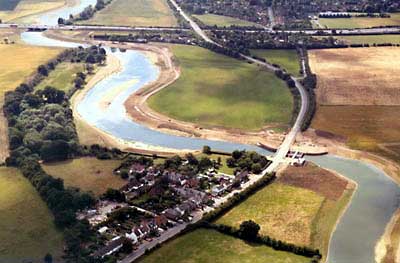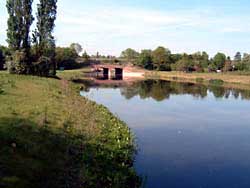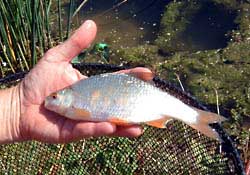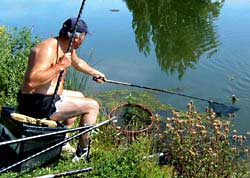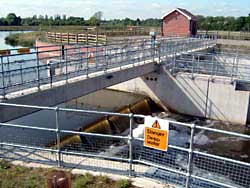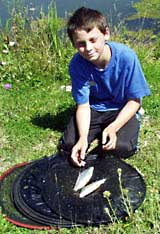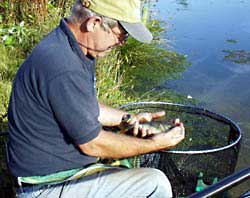Witness now the birth of a new river, the Jubilee River and the first flood relief channel designed with enhancing the ecology as a priority. It is the main channel providing flood protection for the towns of Maidenhead, Eton and Windsor. Intended to take the excess floodwater out of the Thames at Taplow, it bypasses all those towns and falls back into the Thames below Windsor. Normal flow in the Jubilee is around 190 million gallons of water per day, which sounds a lot, but in fact the movement of the water within many of the stretches is barely perceivable. It can be likened to either a very slow moving canal or a Fenland drain. However, when the Thames itself is in flood, then the sluice gates are lowered and more water is allowed through. This is increased until eventually the sluice is opened from the bottom fully as it was last January. Understanding flow rates To explain the technicalities you need to understand the flow rates in “Cumecs” or Cubic Metres per Second. A cubic metre of water (as clever Europhiles will know) is 1000 litres which when converted to Imperial gives you 220 gallons each second. Normal summer flow on the Thames is around 25 Cumecs and on the new Jubilee River is usually no lower than 10 Cumecs, hence the calculation 10 x 19 million gallons (roughly 1 Cumec = 19 million gallons of water in 24 hours) = 190 million gallons of flow per day.
It was officially opened last year, 2002, and in January had its baptism of fire (except that should actually be water!). The Thames, already pushing over the banks, received a lot more water from tributaries such as the Windrush, Cherwell and the Kennet. At times the main flow reached over 300 Cumecs (around 6 BILLION gallons per day) and the sluice gates to the Jubilee were fully opened. No previous testing could possibly have revealed what would happen, but just below the first controlling sluice at Taplow there now stands a manhole which was once surrounded by soil, etc, and is now standing alone in open air propped up by scaffolding. The surrounding soil now being merged with the river bed.
Why it is important to anglers All that apart, why is the new river so important to us anglers? Well, for a start one main stretch has been retained by the Environment Agency with the intention of allowing fishing on it. It runs from the aforementioned railway bridge down to the M4 motorway bridge and is around 2 kilometres in length. There are other stretches that have or will be returned to the original owners, but only one other length has been retained by the EA where angling is completely banned other than a few swims for the disabled at the beginning. This is because it has been designated as a conservation, wildlife and education area for the benefit of visiting schools and the public.
We were a little disappointed with the day, which was (as you will recall) the hottest so far this year, very bright, it was a full moon and with a southerly wind the conditions were appalling. Surprised also because some fish were caught and yet the river has not been stocked. To run down some of the catches: Mick Rowan started fishing very early in the morning and by 8am had caught lots of bleak, two small roach, a good perch, and a skimmer bream. Dick Forty had six nice roach and saw 12 really big bream during the day, albeit it could have been three bream that passed by him four times, but THEY ARE THERE! Next to him young Timmy Marshall had a couple of nice roach also and someone reported a 1lb perch. All of these fish were taken on the pole with very fine elastics and around 1lb hooklengths.
Heaving with big bream in a few years? We expect the fishing will be difficult for some time to come, but I am trying to view it in five or six years time when it is heaving with big bream and could even hold a barbel or two. I also imagine chub getting really big and fat in this new venue and just like their cousins in the Fenland drains, pike could grow to mammoth proportions. For those anglers who have turned their back on rivers can I just say, it doesn’t fish like a river, more like a stillwater. It’s average width is probably 50 metres and the depth averages 4 metres in the middle. I really do see this new river as being the biggest thing to happen to coarse fishing in the past 50 years or more. And before it is mentioned, we are aware of the cormorants, but the EA have promised fish refuges where necessary. If we do get really big shoals of bream, they will avoid the cormorant threat. Plus the EA have planted up lots of reed areas that will encourage spawning as well as providing a home for the waterfowl.
Before closing I must also mention the hospitality of Tony Proud who is the EA’s Jubilee River keeper (a short way of describing his job title) and John Sutton, EA Fisheries Manager for Thames Region. I also offer my grateful thanks to Dr Alan Butterworth for kindly allowing me to use some of his photographs. You see, the EA Rod Licence is really worth it, you just have to get to know your people in the fisheries department. |
Welcome!Log into your account










